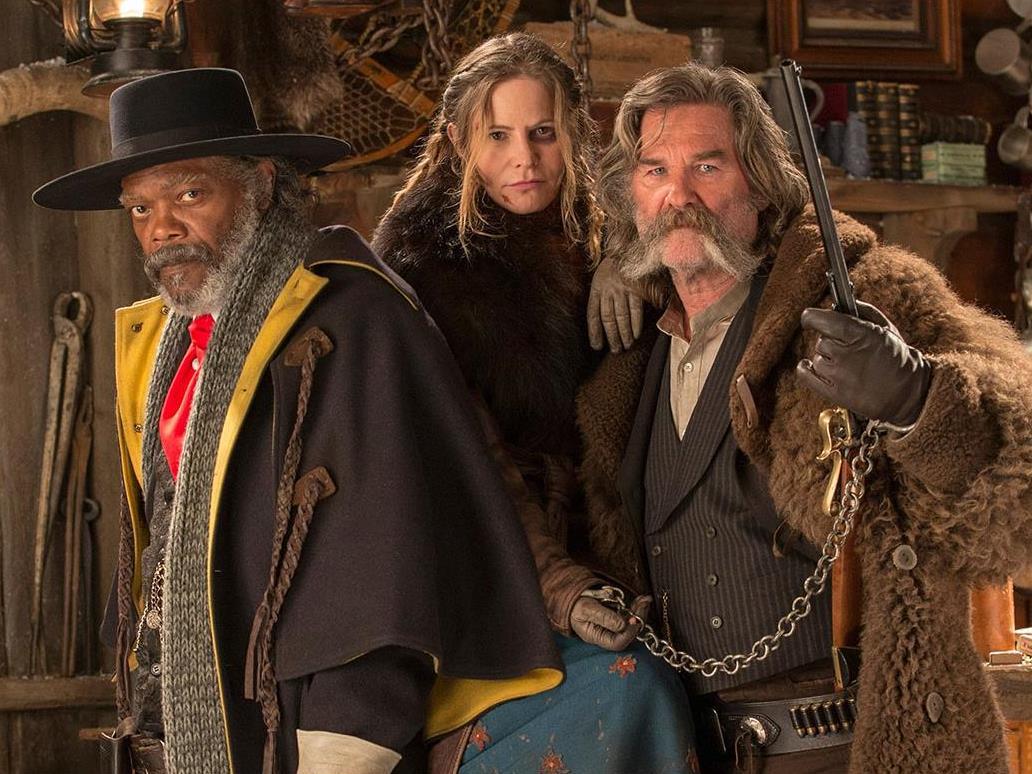Brandishing the title The Hateful Eight, the latest film by Quentin Tarantino instantly makes its mood and focus plain. An octet of unfriendly folks is destined to cross paths — and, extrapolating from the writer/director’s back catalogue, devolve into a cycle of bantering, conflict, violence and confrontation. Indeed, there’s much about the eighth feature by the Pulp Fiction, Kill Bill and Inglorious Basterds filmmaker that proves apparent from the outset, including a cast littered with familiar faces from his previous work, and his second consecutive stint tackling the western genre after Django Unchained. Each ensures the 167-minute effort elicits interest, but it’s what Tarantino does with them that retains it.
Several years after the American Civil War, the titular group share shelter in Wyoming during a blizzard, with Minnie’s Haberdashery their chosen port of call. En route to Red Rock with wanted criminal Daisy Domergue (Jennifer Jason Leigh, Anomalisa), bounty hunter John ‘the Hangman’ Ruth (Kurt Russell, Bone Tomahawk) encounters Major Marquis Warren (Samuel L. Jackson, Avengers: Age of Ultron), a colleague on a similar quest with deceased cargo, as well as Chris Mannix (Walton Goggins, American Ultra), who claims to be their destination’s new sheriff. At the general store they intend to bunker down in until the storm passes, they meet more unexpected parties: Mexican Bob (Demián Bichir, TV’s The Bridge), General Sandy Smithers (Bruce Dern, Nebraska), executioner Oswaldo Mobray (Tim Roth, Chronic), and cow puncher Joe Gage (Michael Madsen, 24). A tentative alliance springs from necessity, though Ruth remains cautious about his cohort’s true motives, believing one or several are planning to free his charge.
Swiftly, the acrimonious bunch of recognisable western types is bickering. Prior to their arrival, Domergue, Ruth, Warren and Mannix are as well. Tarantino’s way with words has served him well since 1992’s Reservoir Dogs, continuing to do so in an outing that bears more than a little resemblance to a western version of that debut; however watching the performers speak his dialogue is one of The Hateful Eight‘s pleasures as much as the dialogue itself. Indeed, seeing a cast come together — their selection not only validated, nor their talents merely displayed, but their presence amplifying the material and complementing their co-stars — remains a highlight of the filmmaker’s oeuvre, his ensemble offerings always improved by those on screen. Here, while Jackson emboldens the film with the silver-tongued voicing of Tarantino’s notoriously verbose text, Leigh cycles through the roles of villain and victim and back again through her physicality and posture. Goggins and Roth brighten a dark screenplay with their respective comic timing and eccentricity, with Russell remaining righteous, gruff and blustering in opposition.
Tarantino’s technique favours many individual moving pieces, but guarantees that they always add up to the exact sum of their parts. The layering of his actors and the characters they portray may form the centrepiece of his approach — and within a screenplay seething with mistrust and constantly forcing both its central figures and their viewers to question their allegiances, they offer quite the focal point — yet in The Hateful Eight, his statement and style demand just as much notice. Ribald language thunders from the screen in fiery exchanges and feverish monologues, designed to provoke attention regarding the treatment of gender, race and other divisions that can plague a nation. Vast, snowy vistas inspire an expansive tone, only for claustrophobic interiors to bleakly snatch it away. The movie is lengthy, often too patient and sometimes too pronounced, but frequently ramps up the momentum and tension, balances its entertaining tendencies with its streak of unease, and thrusts the story forward. There’s a rhythm to the way each cast member interacts, how every chapter and timeline runs its course, where cinematographer Robert Richardson’s (Hugo) camera lingers and zooms, and when composer Ennio Morricone’s (The Best Offer) score resounds and fades, that gives the film the weight and texture it should.
Of course, in a select number of cinemas The Hateful Eight boasts even more heft and grain, with the feature not only shot on Ultra Panavision 70mm, a format last used fifty years ago, but projected on 70mm during a limited-run roadshow season. An overture blasts Morricone’s equally rousing and foreboding sounds before the film’s visuals are seen, an intermission provides a mid-movie respite at an opportune time, and the images flicker with the softness of celluloid rather than the sharpness of digital. In this format, Tarantino’s intentions become more blatant, blending the old and the known with the fresh and subversive to craft an effort that’s as familiar as it is surprising in several fashions. The Hateful Eight brings together all of the indulgences audiences expect from its director, the hallmarks of his prior works, his continued fascination with a particular genre, his skill for filtering homage through his own exploitation-focused lens, and his knack for casting among them, then playfully twists them into the immense yet insular, talky yet contemplative, picturesque yet blood-splattered mystery-western you both did and didn’t know he had in him.
Rating: 4 stars out of 5
The Hateful Eight
Director: Quentin Tarantino
USA, 2015, 167 mins
Release date: January 21
Distributor: Roadshow
Rated: R
Actors:
Director:
Format:
Country:
Release:





